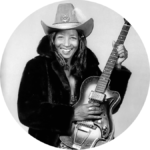
Jessie Mae Hemphill cut a unique and colorful figure as queen of the North Mississippi Hill Country blues scene. A three-time winner as traditional female blues artist of the year in the 1987, 1988 and 1994 W.C. Handy Blues Awards (later renamed the Blues Music Awards), Hemphill came from a long line of musicians dating back to her great-grandfather Dock Hemphill and including her parents and aunts as well as her grandfather, Sid Hemphill, who recorded for Alan Lomax and Lewis Jones in 1942. Her rhythmic, rough-hewn music was spirited and gritty–unadorned, in contrast to her sequined apparel, wigs, cowboy hats, and other bold accoutrements.
Born Jessie Mae Graham in Panola, Mississippi, on October 18, 1923 (a decade before the birthdate she claimed), she learned drums and guitar as a child and played in various fife and drum bands at Hill Country picnics over the years, first with Sid Hemphill and later with Napolian Strickland, Otha Turner and others. She lived in Memphis on and off during the 1940s and ‘50s and worked as an elevator operator and as a waitress at several cafes and clubs. She performed at times but her musical career did not gain momentum until she began recording and touring as a singer-guitarist in the late 1970s. To enhance the rhythmic impact of her modal one-chord style, she also played a tambourine with her foot and later added ankle bells.
Folklorist George Mitchell first recorded Hemphill in 1967 but those sides were not released until 2008 by Fat Possum. David Evans of Memphis State University produced most of Hemphill’s records and also played guitar behind her on many sessions and personal appearances. Two singles and an LP were released on the university’s High Water label, but the first album, “She-Wolf,” came out on a French label, Vogue, in 1981. Other labels including Hightone/HMG, Inside Sounds and Mississippi Records, also later released material from Evans’ sessions. The High Water LP “Feelin’ Good” won a 1991 Handy Award. Her work has also been featured on Black & Blue and Wolf. Hemphill played a drum on a 1980 European tour (the first by an African-American fife and drum band) and in the 1991 documentary “Deep Blues.” She and Abe Young played drums with fife blower Otha Turner on the childrens’ TV show “Mister Rogers’ Neighborhood” in 1982. She was later featured in a French documentary by Marc Oriol, “Me & My Guitar, Jessie Mae Hemphill.”
Hemphill became a favorite on the traditional blues circuit in the U.S. and internationally but her blues career was cut short by a stroke in 1993 that left her unable to play guitar. She still entertained visitors with her stories at her trailer home and could still sing and play tambourine—but abdicated the blues and devoted herself to gospel music. Her last recording was a double gospel CD also released on DVD, “Dare You to Do It Again,” in 2004, on 219 Records. Hemphill died in Memphis hospital on October 22, 2006. A Mississippi Blues Trail marker was placed in 2011 at the cemetery where she was buried in Senatobia.
